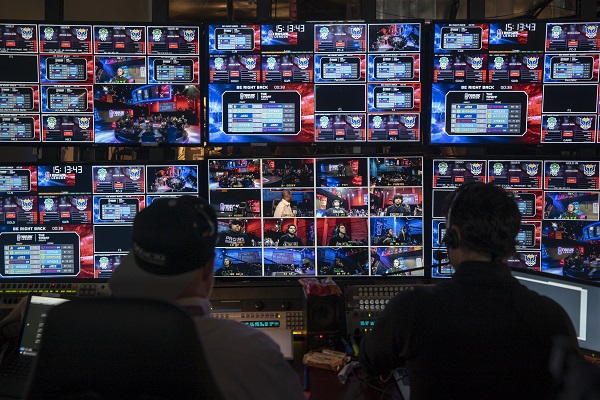NBA 2K Shoots for Live and Streamed Excitement
NBA fans have a new spectator sport to get them through that long summertime pause between seasons. It’s the NBA 2K League, and its widely recruited professional athletes are redefining athleticism and spectatorship. Yes, it’s esports, but it’s the big leagues, operated as a collaboration between the NBA and Take-Two Interactive Software.
The growing popularity of esports has many speculating about how the competitions will change the fan experience, both inside the studios hosting the sport, and beyond to the streaming audience. The NBA 2K Studio set a media-rich benchmark, populating its competition arena with plenty of video to provide engagement for today’s content-hungry sports fans.
The NBA 2K production, installed on a 7,433-square-foot soundstage at Brooklyn Studios for the duration of the May-September season, was developed by event producers Defacto Entertainment and experiential designers MEPTIK. Built around a raised central stage where gamers face each other five-on-five with their backs to the audience, the video setup was optimized to show the “on-court” action and also get up close to each player, displaying a live feed of their faces on dedicated screens above every station.
Studio audiences and streaming viewers all enjoy clear sight lines to the video close-ups of each player, thanks to the cleverly conceived oval-shaped hang of 10 LCD displays above the players’ heads, known as “the boat” among the production crew. Boosting the adrenaline further are large-scale LED displays and two enormous projection screens that show the in-game action.
With esports, of course, the game action would be mostly invisible to the viewer without an assist from large-scale video displays magnifying what the players see on their individual screens. The same is true for watching the athletes themselves, who are positioned in deep lounge chairs on stage with their backs to the audience. Dedicated cameras reveal each player’s facial expressions and action, while an audio feed from their headsets provides fans with insider access to interaction among teammates.
The set design was created in such a way that the numerous video displays, along with the audience seating areas, provide additional visual imagery to that of the game play in streamed video of the event, heightening the action for remote viewers.
“The in-room experience is the main thing, just as with any sporting event, and then you also have the broadcast of the event,” explains Nick Rivero, Co-Founder of MEPTIK. “Even though there’s a comparatively small studio audience for every game, they still wanted to capture that presence in the room on camera, to add to the overall experience.”
 Handling the massive amount of video playback in the studio is a customized media server system that MEPTIK created based on Renewed Visions ProVideoPlayer3 system. Capture and playback capabilities are provided by Blackmagic Design’s DeckLink Duo 2.
Handling the massive amount of video playback in the studio is a customized media server system that MEPTIK created based on Renewed Visions ProVideoPlayer3 system. Capture and playback capabilities are provided by Blackmagic Design’s DeckLink Duo 2.
Just as in any sports application, the displays on set also feature statistics, motion graphics and sponsor branding. “Everything is driven from a single system, with just the click of a single button,” Rivero explains. That makes it easy to trigger the “takeover moments” popular throughout live-sports production, when choreographed content dominates all displays during certain periods of play.
“Similar concepts to the larger sporting world, when the whole stadium or arena goes crazy, apply in this experience,” Rivero says. “The overall idea was for people in the room to have that same energy and experience of a live event.”
With the first NBA 2K season completed (and the next regular NBA season just gearing up), the reviews of the esport experience are in and fans love it. Much of the intensity of live sports happens with video game play, too, according to Rivero. “It’s very similar to an actual sporting event,” he observes. “The same emotions run, the same ambience, you get that same tension. It looks different, but it’s the same feeling.”




